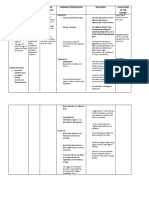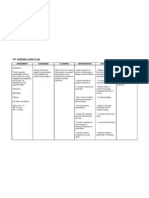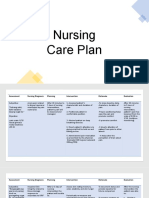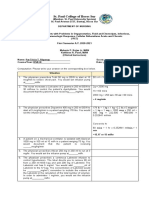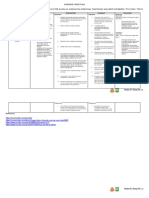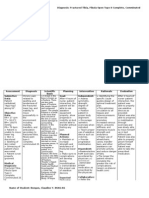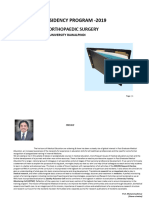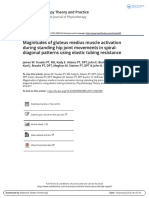0 ratings0% found this document useful (0 votes)
79 viewsNCP 2
NCP 2
Uploaded by
JOPEARL MAE DELA TORRE1. The patient presented with a fractured tibia and fibula from a fall, which caused chronic pain, swelling, and inability to move the lower leg.
2. After 4 hours of interaction with the nurse, the patient was able to properly use assistive devices and show progress in mobility without pain.
3. The goals of treatment were to relieve pain, prevent complications, and restore mobility and independence through exercises and proper use of assistive devices.
Copyright:
© All Rights Reserved
Available Formats
Download as DOC, PDF, TXT or read online from Scribd
NCP 2
NCP 2
Uploaded by
JOPEARL MAE DELA TORRE0 ratings0% found this document useful (0 votes)
79 views2 pages1. The patient presented with a fractured tibia and fibula from a fall, which caused chronic pain, swelling, and inability to move the lower leg.
2. After 4 hours of interaction with the nurse, the patient was able to properly use assistive devices and show progress in mobility without pain.
3. The goals of treatment were to relieve pain, prevent complications, and restore mobility and independence through exercises and proper use of assistive devices.
Original Title
36571311-NCP-2
Copyright
© © All Rights Reserved
Available Formats
DOC, PDF, TXT or read online from Scribd
Share this document
Did you find this document useful?
Is this content inappropriate?
1. The patient presented with a fractured tibia and fibula from a fall, which caused chronic pain, swelling, and inability to move the lower leg.
2. After 4 hours of interaction with the nurse, the patient was able to properly use assistive devices and show progress in mobility without pain.
3. The goals of treatment were to relieve pain, prevent complications, and restore mobility and independence through exercises and proper use of assistive devices.
Copyright:
© All Rights Reserved
Available Formats
Download as DOC, PDF, TXT or read online from Scribd
Download as doc, pdf, or txt
0 ratings0% found this document useful (0 votes)
79 views2 pagesNCP 2
NCP 2
Uploaded by
JOPEARL MAE DELA TORRE1. The patient presented with a fractured tibia and fibula from a fall, which caused chronic pain, swelling, and inability to move the lower leg.
2. After 4 hours of interaction with the nurse, the patient was able to properly use assistive devices and show progress in mobility without pain.
3. The goals of treatment were to relieve pain, prevent complications, and restore mobility and independence through exercises and proper use of assistive devices.
Copyright:
© All Rights Reserved
Available Formats
Download as DOC, PDF, TXT or read online from Scribd
Download as doc, pdf, or txt
You are on page 1of 2
Patient: Mr.
R Diagnosis: Fractured Tibia, Fibula Open Type II Complete, Comminuted 25 M
Assessment Diagnosis Scientific Basis Planning Intervention Rationale Evaluation
Subjective Data: Chronic pain > A break in the Goal: Independent: > Identifying the After 4 hours of
Patient verbalized,related to swelling bone is known as a After 4 hours of > Assess specific cause guides nurse- patient
fracture. There are
“Ngul-ngul akong and tenderness of nurse- patient symmetry, design of optimal interaction, the
two main types of
tiil”. the fractured fracture: the simple
interaction, the strength, degree treatment plan. patient was able
lower leg, and (close) and patient will be of mobility. >This optimizes to properly use
Objective Data: inability to move compound (open). able to use > Position patient circulation to all assistive devices
RR= 27 cpm purposefully in the The simple fracture assistive in proper body tissues and relieves as provided.
T°= 36.6°C environment is a break in the equipment alignment. pressure. Patient was also
bone that does not
BP= 100/70 including mobility, properly, show > Encourage >Exercise promotes able to progress
pierce the skin or
mmHg transfers, and cause severe
progress in isometric exercises increased venous in mobilization
PR= 76 bpm ambulation damage to mobility on bed, when indicated. return, prevents through exercises
> Patient is secondary to surrounding tissues. and be able to > Teach proper stiffness, and and was slowly
unable to move fractured tibia, In the compound transfer without use of assistive maintains muscle able to move
lower leg. fibula open type fracture, the skin feeling any pain. device such as strength and himself up in bed
and tissues are
> Skin is II complete, crutches. endurance. without pain.
broken through. A
discolored comminuted 25 fracture may also be
Planned Actions: > Provide >Proper use of Patient was also
> Swelling of M. complete, dividing the > Maintain or progressive wheelchairs, canes, able to properly
skin noted bone into two or increase strength mobilization. transfer bars, and groom himself
> Grimacing of more separate and endurance of other assistance can without help.
patient’s face was pieces. It may be fractured lower Dependent: promote activity and Patient was able
also incomplete or
noted leg. >Passive/active reduce danger of to take the
partial. In a
> Patient is not comminuted fracture,
> Make sure no ROM exercises as falls. prescribed
properly groomed the bone is broken complications will ordered by >The longer the medication.
into little pieces at develop during physician to the injured patient remains
the point of fracture. body part.
Medical Diagnosis: (Reader’s Digest immobilization. > Administer proper immobile the greater
Fractured Tibia, Family Health Guide > Demonstrate medication as the risk of
and Medical
Fibula Open Type the proper use of prescribed by the complications.
Encyclopedia)
II Complete, > Lower leg
assistive devices. physician. (www1.us.elsevierheal
Comminuted 25 fractures include the th.com)
M fractures of the tibia Expected Collaborative:
and fibula. Of these Outcome: > Refer the
two bones, the tibia > Patient would patient to a PT
is the only weight
be able to move or an OT.
bearing bone.
Fractures of the tibia
lower leg with
are generally less pain.
associated with fibula > Patient will be
fracture because the able to groom
force is transmitted himself.
along the
> Patient will be
interosseous
membrane to the
relieved from pain
fibula. after administering
(eMedicine.com) proper medication.
> Causes include
direct forces such as
those caused by falls
and motor vehicle
accident.
(eMedicine.com)
Name of Student: Bongon, Claudine Y. BSN1-N1
You might also like
- Atlas of Oral and Extraoral Bone Harvesting - Marx 2010 PDFDocument161 pagesAtlas of Oral and Extraoral Bone Harvesting - Marx 2010 PDFAB MISHRANo ratings yet
- Case Study 2Document7 pagesCase Study 2desdav100% (1)
- Module 1 Am Activity On Prioritization v2Document5 pagesModule 1 Am Activity On Prioritization v2KeanuNo ratings yet
- Ace Practice TestDocument55 pagesAce Practice TestWeeHoe Lim100% (1)
- Key Hypnosis Progressive Muscle Relaxation ScriptDocument6 pagesKey Hypnosis Progressive Muscle Relaxation Scriptsolidnaz100% (1)
- Rle Worksheet Nursing ProcessDocument6 pagesRle Worksheet Nursing ProcessMARVIE JOY BALUMA CABIOCNo ratings yet
- Muscle Name Table KpattonDocument4 pagesMuscle Name Table Kpattonapi-222239614100% (1)
- Marma ShastraDocument15 pagesMarma ShastraRam L Patil100% (6)
- Nursing Care Plan: Fahad Saad Alenzi 381007055 SA 30 FractureDocument1 pageNursing Care Plan: Fahad Saad Alenzi 381007055 SA 30 FracturefahadNo ratings yet
- NCPDocument14 pagesNCPRaidis Pangilinan0% (1)
- DX Fracture PDFDocument8 pagesDX Fracture PDFSherree HayesNo ratings yet
- NCP Proper CholecystectomyDocument2 pagesNCP Proper CholecystectomyGail Lian SantosNo ratings yet
- NCP Mandibular)Document5 pagesNCP Mandibular)yellarfNo ratings yet
- Problem List Assessment Nursing Diagnosis Planning ImplementationDocument1 pageProblem List Assessment Nursing Diagnosis Planning ImplementationJai Go100% (1)
- Viii. Nursing Care Plan: Asessment Diagnosis Planning Intervention Rationale EvaluationDocument3 pagesViii. Nursing Care Plan: Asessment Diagnosis Planning Intervention Rationale Evaluationhehehe29No ratings yet
- Impaired Physical Mobility R/T Neuromuscular ImpairmentDocument3 pagesImpaired Physical Mobility R/T Neuromuscular ImpairmentjisooNo ratings yet
- NCP DobDocument2 pagesNCP DobPaulo GeneraloNo ratings yet
- Ncp. Acute PainDocument4 pagesNcp. Acute PainNathalie SamonteNo ratings yet
- NCP Hip FractureDocument5 pagesNCP Hip FractureCherry Ann BalagotNo ratings yet
- NCPDocument6 pagesNCPNik Rose ElNo ratings yet
- Assessment Diagnosis Planning Intervention Rationale EvaluationDocument4 pagesAssessment Diagnosis Planning Intervention Rationale EvaluationJhoizel VenusNo ratings yet
- Drug StudyDocument8 pagesDrug StudyJohn Ronald P. RamosNo ratings yet
- NCP On DyspneaDocument5 pagesNCP On DyspneaDizzy BualanNo ratings yet
- NCP InfectionDocument3 pagesNCP InfectionPrince AhmirNo ratings yet
- NCP Self CaRE DeficitDocument1 pageNCP Self CaRE Deficitnicole pageNo ratings yet
- NURSING CARE PLAN - Risk For Fluid Volume DeficitDocument2 pagesNURSING CARE PLAN - Risk For Fluid Volume DeficitDaniel Andre S. SomorayNo ratings yet
- Assessment Explanation of The Problem Planning Nursing Intervention Rationale EvaluationDocument2 pagesAssessment Explanation of The Problem Planning Nursing Intervention Rationale EvaluationRodolfo Bong SemaneroNo ratings yet
- NCP Impaired Physical MobilityDocument1 pageNCP Impaired Physical MobilityCharmaine SolimanNo ratings yet
- Subjective:: Assessment Diagnosis Planning Implementation Rationale EvaluationDocument2 pagesSubjective:: Assessment Diagnosis Planning Implementation Rationale EvaluationAyra PunzalanNo ratings yet
- Risk For Peripheral NeurovacularDocument4 pagesRisk For Peripheral NeurovacularRoseben SomidoNo ratings yet
- Pain NCP BillrothDocument2 pagesPain NCP BillrotharjayNo ratings yet
- NCP Altered Bowel EleminationDocument2 pagesNCP Altered Bowel EleminationDianna RoseNo ratings yet
- Cholelithiasis NCP FINALDocument6 pagesCholelithiasis NCP FINALShreshthi VermaNo ratings yet
- NCP PainDocument1 pageNCP Painsitz04No ratings yet
- NCP Acute PainDocument3 pagesNCP Acute Painmanoelsterg50% (2)
- Nursing Care Plan: Cues Nursing Diagnosis Analysis Goal and Objectives Interventions Rationale EvaluationDocument3 pagesNursing Care Plan: Cues Nursing Diagnosis Analysis Goal and Objectives Interventions Rationale EvaluationCalimlim KimNo ratings yet
- Ceftriaxone and CiprofloxacinDocument4 pagesCeftriaxone and CiprofloxacinRae DaWn VaLesNo ratings yet
- NCPDocument5 pagesNCPMcmc Ryan Ferdinand GutierrezNo ratings yet
- Problem Nursing Diagnosis Background Knowledge Goal and Objective Nursing Intervention Rationale EvaluationDocument2 pagesProblem Nursing Diagnosis Background Knowledge Goal and Objective Nursing Intervention Rationale Evaluationcherrymae mataNo ratings yet
- NCP 2 MiDocument16 pagesNCP 2 MiWendy EscalanteNo ratings yet
- Resource Unit. AdwcwdDocument6 pagesResource Unit. AdwcwdGreg Martin OrbegosoNo ratings yet
- Assessment Nursing Diagnosis Planning Implementation Rationale EvaluationDocument1 pageAssessment Nursing Diagnosis Planning Implementation Rationale EvaluationJames PajarilloNo ratings yet
- 11 - NCPsDocument6 pages11 - NCPsellian3leiNo ratings yet
- Nursing Care PlanDocument3 pagesNursing Care PlanCindy MariscotesNo ratings yet
- NCP RheumatoidDocument5 pagesNCP RheumatoidJane Elizabeth Gonzales MacahiaNo ratings yet
- NCPDocument3 pagesNCPLeslie PaguioNo ratings yet
- Nursing Care PlanDocument5 pagesNursing Care PlankingpinNo ratings yet
- NCPDocument3 pagesNCPErica Denice CastilloNo ratings yet
- Decreased Cardiac OutputDocument5 pagesDecreased Cardiac Outputshuang81No ratings yet
- NCP For Ulnar SurgeryDocument5 pagesNCP For Ulnar SurgeryjiloNo ratings yet
- Project On Hospital Training: Diploma in Hemodialysis TechnicianDocument47 pagesProject On Hospital Training: Diploma in Hemodialysis TechnicianS V ENTERPRISESNo ratings yet
- Cues/ Clues Diagnosis Analysis Objectives Intervention S Rationale EvaluationDocument8 pagesCues/ Clues Diagnosis Analysis Objectives Intervention S Rationale EvaluationRecah PangilinanNo ratings yet
- GE ELEC 5 Activity 4Document2 pagesGE ELEC 5 Activity 4Jewel100% (1)
- Impaired Physical Mobility...Document3 pagesImpaired Physical Mobility...Christy BerryNo ratings yet
- Ineffective Infant Eating Dynamics NCPDocument1 pageIneffective Infant Eating Dynamics NCPandayaannedhesireeNo ratings yet
- ClarithromycinDocument3 pagesClarithromycinJoshua GonzalesNo ratings yet
- Hernia CaseDocument9 pagesHernia CaseFatima Love Ariate-Arcasetas100% (1)
- NCM 112 Computation 2021Document3 pagesNCM 112 Computation 2021Marie Kelsey Acena Macaraig100% (1)
- Metronidazole Drug StudyDocument4 pagesMetronidazole Drug StudyJC LumayaNo ratings yet
- Assessment Healt H Patte RN Nursing Diagnosis Desired Outcome (Edit) Intervention (Edit) Evaluation (EDIT) Rema RKSDocument3 pagesAssessment Healt H Patte RN Nursing Diagnosis Desired Outcome (Edit) Intervention (Edit) Evaluation (EDIT) Rema RKStflorenzNo ratings yet
- Nursing Care Plan: Cues Objectives Interventions Rationale EvaluationDocument2 pagesNursing Care Plan: Cues Objectives Interventions Rationale EvaluationJP2001100% (1)
- Ventricular Septal Defect, A Simple Guide To The Condition, Treatment And Related ConditionsFrom EverandVentricular Septal Defect, A Simple Guide To The Condition, Treatment And Related ConditionsNo ratings yet
- The Ride of Your Life: What I Learned about God, Love, and Adventure by Teaching My Son to Ride a BikeFrom EverandThe Ride of Your Life: What I Learned about God, Love, and Adventure by Teaching My Son to Ride a BikeRating: 4.5 out of 5 stars4.5/5 (2)
- NCP 2Document3 pagesNCP 2klawdin100% (1)
- NCP For Pain - Rheumatoid ArthritisDocument5 pagesNCP For Pain - Rheumatoid Arthritisveorjan100% (1)
- NSTP02 Project Brief and Program of ActionDocument3 pagesNSTP02 Project Brief and Program of ActionJOPEARL MAE DELA TORRENo ratings yet
- CHN 1 Topic 1 HandoutsDocument28 pagesCHN 1 Topic 1 HandoutsJOPEARL MAE DELA TORRENo ratings yet
- General Discussion ScheduleDocument33 pagesGeneral Discussion ScheduleJOPEARL MAE DELA TORRENo ratings yet
- General Discussion ScheduleDocument20 pagesGeneral Discussion ScheduleJOPEARL MAE DELA TORRENo ratings yet
- General Discussion ScheduleDocument13 pagesGeneral Discussion ScheduleJOPEARL MAE DELA TORRENo ratings yet
- General Discussion Schedule: 1 Semester School Year: 2021-2022Document16 pagesGeneral Discussion Schedule: 1 Semester School Year: 2021-2022JOPEARL MAE DELA TORRENo ratings yet
- General Discussion ScheduleDocument28 pagesGeneral Discussion ScheduleJOPEARL MAE DELA TORRENo ratings yet
- Instruction - Read Genesis 1 - 1 - 2 - 3 and GenesisDocument6 pagesInstruction - Read Genesis 1 - 1 - 2 - 3 and GenesisJOPEARL MAE DELA TORRENo ratings yet
- Trinity University of Asia: Department of Education Christian EducationDocument2 pagesTrinity University of Asia: Department of Education Christian EducationJOPEARL MAE DELA TORRENo ratings yet
- Dr. K. Sendhil Kumar Dr. Piyush Patwa Dr. Latif Bagwan Gateway Clinic & Hospitals Coimbatore, INDIADocument62 pagesDr. K. Sendhil Kumar Dr. Piyush Patwa Dr. Latif Bagwan Gateway Clinic & Hospitals Coimbatore, INDIAJOPEARL MAE DELA TORRE100% (1)
- Ortho Log BookDocument130 pagesOrtho Log Bookmouda mohsenNo ratings yet
- Magnitudes of Gluteus Medius Muscle Activation During Standing Hip Joint Movements in Spiral-Diagonal Patterns Using Elastic Tubing ResistanceDocument9 pagesMagnitudes of Gluteus Medius Muscle Activation During Standing Hip Joint Movements in Spiral-Diagonal Patterns Using Elastic Tubing ResistanceHONGJYNo ratings yet
- Section 2 - Lower Limb AnatomyDocument58 pagesSection 2 - Lower Limb AnatomyAliyah LuharNo ratings yet
- Femoral Injecting Resource PDFDocument7 pagesFemoral Injecting Resource PDFAline CidNo ratings yet
- Exclusive Ospe Notebook 1 1Document50 pagesExclusive Ospe Notebook 1 1Naeem Al HasanNo ratings yet
- Lower Limbs PracticalDocument45 pagesLower Limbs PracticalOleashedNo ratings yet
- Promotion Exam 2008-2016 by Saud AlmaslmaniDocument98 pagesPromotion Exam 2008-2016 by Saud AlmaslmaniAlHasa100% (1)
- 49 - Anna's ArchiveDocument492 pages49 - Anna's Archivedinovaalfito04No ratings yet
- Month 9 20 Months To A Champion Physique by Bill PearlDocument5 pagesMonth 9 20 Months To A Champion Physique by Bill Pearlw2tyswwrnxNo ratings yet
- Musculoskeletal System Lecture NotesDocument169 pagesMusculoskeletal System Lecture Noteszygote0711578796% (28)
- Combat Boot Palsy: Case Reports: F. GafensDocument3 pagesCombat Boot Palsy: Case Reports: F. GafensAbdelghani MILIANINo ratings yet
- 3 - JT-2019-003TangoPostureDocument15 pages3 - JT-2019-003TangoPostureCsongor KicsiNo ratings yet
- Medical MalalignmentDocument20 pagesMedical MalalignmentMihaela Tulbure100% (1)
- Balance Exercise PDFDocument18 pagesBalance Exercise PDFAdrian100% (1)
- The Flexible ApproachDocument9 pagesThe Flexible ApproachBrian Le VuNo ratings yet
- Keiser PerformanceDocument22 pagesKeiser PerformanceВиталий БартулёвNo ratings yet
- Muscle Manual From Active IQDocument81 pagesMuscle Manual From Active IQRicardoMontenegroMartinezNo ratings yet
- OSCE-Surgery Block PDFDocument31 pagesOSCE-Surgery Block PDFmisstina.19876007100% (2)
- GROSS HSB A Prelim 2018Document18 pagesGROSS HSB A Prelim 2018nge257No ratings yet
- Muscular SystemDocument117 pagesMuscular SystemAiman Bañaga Arabain100% (1)
- Yoga AsanasDocument174 pagesYoga AsanasMax NovaxNo ratings yet
- ANAT1012.1019 Example Regional Lower Limb SAQ's - 2022Document3 pagesANAT1012.1019 Example Regional Lower Limb SAQ's - 2022Grace YNo ratings yet
- Giles Set CDocument45 pagesGiles Set CPrinting CoNo ratings yet
- Transversus Abdominis Plane (Tap)Document5 pagesTransversus Abdominis Plane (Tap)Edwin mudumiNo ratings yet











